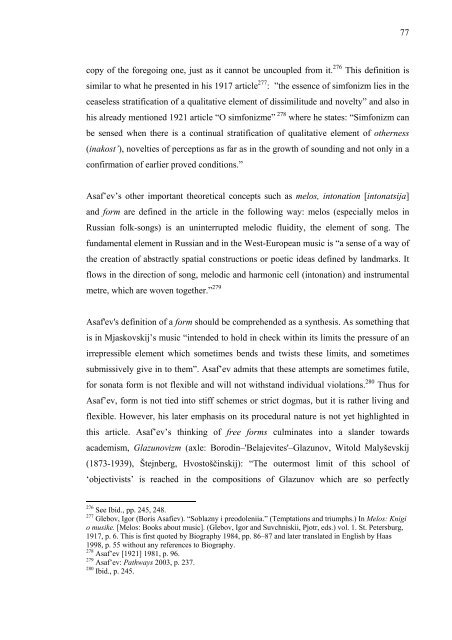Boris Asaf'ev and the Soviet Musicology - E-thesis
Boris Asaf'ev and the Soviet Musicology - E-thesis
Boris Asaf'ev and the Soviet Musicology - E-thesis
You also want an ePaper? Increase the reach of your titles
YUMPU automatically turns print PDFs into web optimized ePapers that Google loves.
copy of <strong>the</strong> foregoing one, just as it cannot be uncoupled from it. 276 This definition is<br />
similar to what he presented in his 1917 article 277 : ”<strong>the</strong> essence of simfonizm lies in <strong>the</strong><br />
ceaseless stratification of a qualitative element of dissimilitude <strong>and</strong> novelty” <strong>and</strong> also in<br />
his already mentioned 1921 article “O simfonizme” 278 where he states: “Simfonizm can<br />
be sensed when <strong>the</strong>re is a continual stratification of qualitative element of o<strong>the</strong>rness<br />
(inakost’), novelties of perceptions as far as in <strong>the</strong> growth of sounding <strong>and</strong> not only in a<br />
confirmation of earlier proved conditions.”<br />
Asaf’ev’s o<strong>the</strong>r important <strong>the</strong>oretical concepts such as melos, intonation [intonatsija]<br />
<strong>and</strong> form are defined in <strong>the</strong> article in <strong>the</strong> following way: melos (especially melos in<br />
Russian folk-songs) is an uninterrupted melodic fluidity, <strong>the</strong> element of song. The<br />
fundamental element in Russian <strong>and</strong> in <strong>the</strong> West-European music is “a sense of a way of<br />
<strong>the</strong> creation of abstractly spatial constructions or poetic ideas defined by l<strong>and</strong>marks. It<br />
flows in <strong>the</strong> direction of song, melodic <strong>and</strong> harmonic cell (intonation) <strong>and</strong> instrumental<br />
metre, which are woven toge<strong>the</strong>r.” 279<br />
<strong>Asaf'ev</strong>'s definition of a form should be comprehended as a syn<strong>the</strong>sis. As something that<br />
is in Mjaskovskij’s music “intended to hold in check within its limits <strong>the</strong> pressure of an<br />
irrepressible element which sometimes bends <strong>and</strong> twists <strong>the</strong>se limits, <strong>and</strong> sometimes<br />
submissively give in to <strong>the</strong>m”. Asaf’ev admits that <strong>the</strong>se attempts are sometimes futile,<br />
for sonata form is not flexible <strong>and</strong> will not withst<strong>and</strong> individual violations. 280 Thus for<br />
Asaf’ev, form is not tied into stiff schemes or strict dogmas, but it is ra<strong>the</strong>r living <strong>and</strong><br />
flexible. However, his later emphasis on its procedural nature is not yet highlighted in<br />
this article. Asaf’ev’s thinking of free forms culminates into a sl<strong>and</strong>er towards<br />
academism, Glazunovizm (axle: Borodin–'Belajevites'–Glazunov, Witold Malyševskij<br />
(1873-1939), Štejnberg, Hvostoščinskij): “The outermost limit of this school of<br />
‘objectivists’ is reached in <strong>the</strong> compositions of Glazunov which are so perfectly<br />
276 See Ibid., pp. 245, 248.<br />
277 Glebov, Igor (<strong>Boris</strong> Asafiev). “Soblazny i preodoleniia.” (Temptations <strong>and</strong> triumphs.) In Melos: Knigi<br />
o musike. [Melos: Books about music]. (Glebov, Igor <strong>and</strong> Suvchniskii, Pjotr, eds.) vol. 1. St. Petersburg,<br />
1917, p. 6. This is first quoted by Biography 1984, pp. 86–87 <strong>and</strong> later translated in English by Haas<br />
1998, p. 55 without any references to Biography.<br />
278 Asaf’ev [1921] 1981, p. 96.<br />
279 Asaf’ev: Pathways 2003, p. 237.<br />
280 Ibid., p. 245.<br />
77

















